NTT develops ultra-compact baseband amplifier IC module with built-in DC block function, 100GHz bandwidth performance
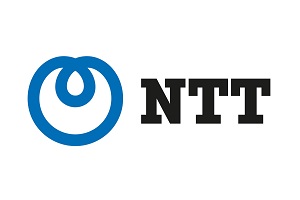
NTT Corporation has developed an ultra-compact baseband amplifier IC module with an ultra-broadband performance of 100GHz. This technology is expected to be used in future all-photonics networks, namely IOWN and 6G, and fields achieving measurements since they will require an ultra-broadband signal amplification function rid of distortion.
To achieve this, NTT applied its InP-based heterojunction bipolar transistor (InP HBT) technology to improve the performance of amplifier ICs and package mounting technology to incorporate a DC block function with 100 GHz bandwidth performance, realising an ultra-compact amplifier IC module. In addition, since NTT’s development has a built-in DC block function and is ultra-compact, it can be directly connected to various devices, making it a highly usable module.
This result will enable ultra-high-speed optical communication in the next-generation IOWN network and measurement applications. Details of this technology were published online in IEEE Microwave and Wireless Technology Letters on Feb. 16, 2023.
The COVID-19 pandemic has accelerated the digital transformation of various services, so online communication traffic is exploding. NTT’s core optical network, IOWN, will require transmission speeds of more than 2 terabits per second and a baseband amplifier IC module that can amplify the signal. In addition, in the areas of experimentation and measurement that support such advanced research, there is already a need for ultra-broadband and compact electric amplifiers, and the demand is increasing.
To date, NTT has developed a prototype of an ultra-broadband baseband amplifier IC module with a 1mm coaxial connector and has conducted the world’s first demonstration experiment of optical transmission exceeding 2 terabits per second5. However, previous prototype modules were large and required external DC block parts to connect to the front and rear devices.
By increasing the performance of amplifier ICs using InP HBT technology and advancing package mounting technology, NTT succeeded in realising the world’s first ultra-compact amplifier IC module that achieves both ultra-wideband performance of 100 GHz and DC block function integration (Figure 1).
Fig. 1: Comparison of conventional technology and this result
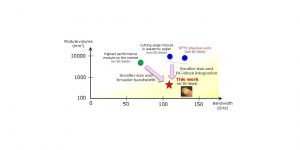
Ultra-broadband baseband amplifier IC based on InP HBT technology
NTT has achieved broad peaking characteristics (characteristics that emphasize gain on the high-frequency side) by further improving the performance of ultra-broadband baseband amplifier ICs using InP HBT technology developed by the company (Figure 2). This peaking characteristic makes it possible to compensate for high-frequency signal loss caused by package mounting and to ensure gain flatness (a characteristic in which a constant amplification factor is obtained from low frequencies to high frequencies) as an amplifier IC module.
Fig. 2: Baseband amplifier IC using InP HBT technology (a) Photo (b) Frequency characteristics
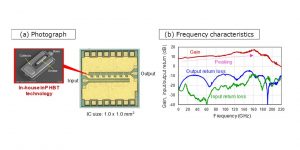
Ultra-broadband/ultra-small package mounting technology
NTT has ensured ultra-broadband characteristics by adopting a push-on type coaxial connector instead of the conventional thread-on type coaxial connector for the interface and devising the design of the joint between the coaxial and the internal high-frequency board. Also, researchers have achieved a drastic reduction in the size of the package. In addition, NTT made full use of precise high-frequency design technology to achieve DC block function integration (which was previously difficult to combine with ultra-wideband characteristics) by mounting a small thin-layer capacitor on the internal high-frequency substrate.
By combining these technologies, NTT achieved both ultra-broadband characteristics of 100 GHz or more and DC block function integration in an ultra-compact size with a volume ratio of less than one-tenth of conventional devices (Fig. 3). Finally, the researchers demonstrated that this amplifier IC module can amplify an ultra-wideband PAM-4 signal with a symbol rate of 112 gigabaud without distortion (Fig. 4).
Fig. 3: Baseband amplifier IC module (a) Configuration block diagram (b) Photo (c) Frequency characteristics
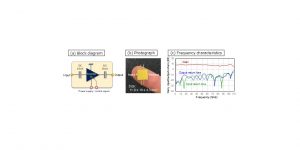
Fig. 4: Amplification experiment result of a 112 gigabaud PAM-4 signal generated by this amplifier IC module
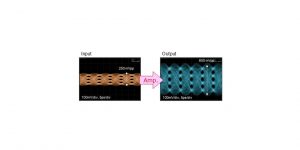
This result will be put into practical use at an early stage in applications where the need for ultra-broadband signal amplification has already become apparent, such as next-generation, ultra-high-speed optical communications and experimental and measuring instrument applications that support the research and development of 6G.
In the medium term, NTT will further improve its IC and package mounting technology and study application for ultra-high-speed optical transceivers in the next-generation IOWN network.
Comment on this article below or via Twitter @IoTGN
